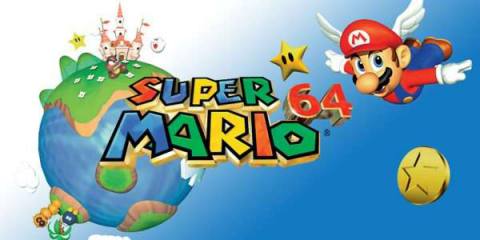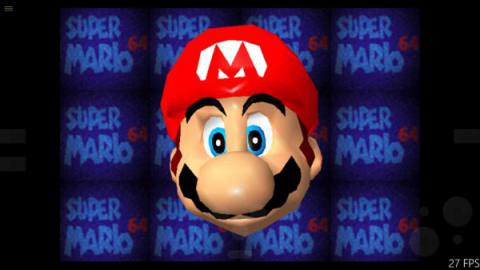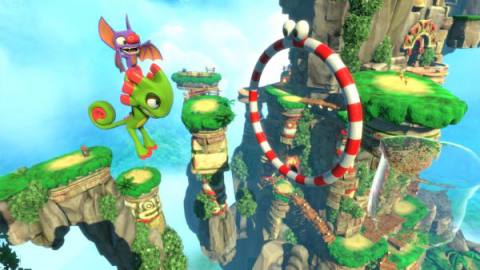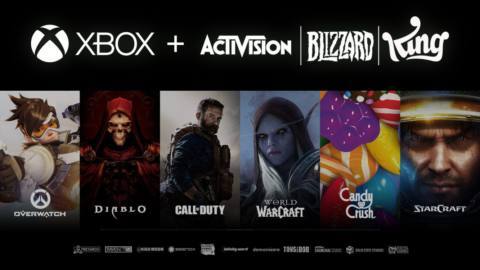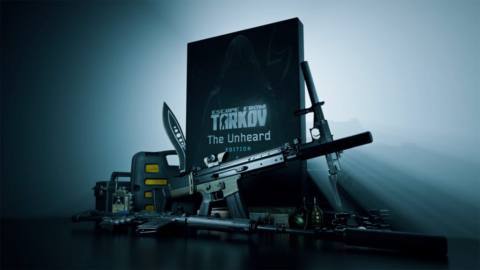Twenty-five years on, we catch up with the developers inspired by Miyamoto’s revolutionary platformer.
“What’s the right word? It was like a milestone, or a watershed – what am I looking for here…”
Tim Schafer, renowned developer and President and CEO of Double Fine Productions, takes a second to think: how exactly did Super Mario 64 impact him when he first played it?
“It was like an epiphany, that’s what I would say: Mario 64 was an epiphany.”
On June 23rd 1996, twenty-five years ago, Super Mario 64 was released in Japan as a launch title for Nintendo’s N64 console. Critics and players alike were astonished by the platformer, which took the world-famous plumber out of the second dimension and popped him into a vibrant, colourful 3D world. Mario himself was a smoothly-animated marvel, steered around with the analogue stick in the middle of the unusual N64 controller. Add in a camera-relative control scheme which was unparalleled at the time, an iconic soundtrack by series veteran Koji Kondo and open-ended, exploration-focused level design, and game developers were stunned.
“Apart from camera criticism, everyone thought it was amazing. It defined the 3D platformer as a genre,” says veteran designer, Co-Founder of id Software and Senior Creative Director for VR developers Resolution Games Tom Hall. “The industry hadn’t really figured out 3D platforming yet, and here it was, a masterwork that set the standard. And it kinda kicked the butt of everything on the N64 after it.”
Directed by the legendary designer and Mario creator Shigeru Miyamoto, the impact of Super Mario 64 continues to be felt in many games created over two decades later. However, to properly tell the story of how Super Mario 64 changed everything, you have to start at the beginning.
Face to Face
When you boot up Mario 64, you’re greeted with a cheerful “hello” from the moustachioed plumber himself, grinning at you against a dark blue background. However, there’s something unusual and delightful about this innocuous title screen: Mario’s face can be twisted and turned like Play-Doh before springing back into its original shape like a rubber band.
The man responsible for this iconic intro is Giles Goddard, CEO of the Kyoto-based studio Chuhai Labs and one of Nintendo’s first western employees. Goddard left school when he was 16 and got his first job working with the now-defunct British development studio Argonaut Games in London. Argonaut Games had produced early 3D games like Starglider, released in 1986, and partnered with Nintendo after commissioning designer Dylan Cuthbert to reverse-engineer the handheld Game Boy console to produce a 3D game demo, eventually released as X in 1992.
“I was really interested in 3D,” Goddard says. “Within a year of starting at Argonaut, we started talking to Nintendo about the potential of doing 3D on stuff like the NES.”
Argonaut realised that more powerful hardware would be needed and subsequently designed the Super FX 3D chip for the SNES to facilitate the creation of games like Star Fox. Goddard moved over to Japan to work with Nintendo, aged just 19, and says that making enjoyable 3D games for the SNES that ran smoothly was challenging. However, 3D games were relatively rare at the time, which gave Goddard and Nintendo lots of freedom.
“You could basically come up with any idea and it would be new, so the world was your oyster,” Goddard says.
Nintendo collaborated with Silicon Graphics Inc on the hardware for what became the Nintendo 64 and Goddard, working in Nintendo EAD’s Research and Development department at the time, remembers receiving an exciting “Indy” workstation to experiment with, complete with a webcam. He wanted to see if the camera could detect him moving, sticking ping-pong balls to his face to be tracked on-screen, and his experiments caught the attention of Miyamoto.
“When I was doing it Miyamoto-san walked past and said ‘ooh that’s cool, why don’t we put it in Mario 64?’ It was really a thing that just happened,” Goddard remembers. “We were all just throwing stuff at a wall and seeing what would stick, basically. That’s kind-of how Nintendo made their games at the time – now they’re a bit more organised.”
“Because we were making games with no precedent and no model, we had no restraints in terms of process and were free to think however we liked about issues,” Takashi Tezuka, Senior Officer of Nintendo Entertainment Planning & Development Division (Nintendo EPD) and Assistant Director on Super Mario 64, told The Washington Post last September. This encouraged developers at Nintendo’s Entertainment Analysis and Development Division [Nintendo EAD] to create sandbox levels that “enabled a freer style of play that wasn’t limited to a single path”, according to Tezuka.
“There was no jumping actions in 3-D we could reference at the time, so we shared in the enjoyment of going through all the trial and error with Mr. Miyamoto and other team members,” Yoshiaki Koizumi, an Executive Officer at Nintendo and Assistant Director on Super Mario 64, said in the same article.
Catch ‘em all
Mario 64 was instrumental for the generation of ‘collectathon’ games which followed it, influencing the likes of Banjo-Kazooie, Donkey Kong 64 and Spyro the Dragon.
“There was a sense that this is going to change everything and that this is going to be the future,” Chris Sutherland, Project Director and Software Engineer at Playtonic Games, says. “It was going to be less of the 2D stuff that we’d been doing and it was going to be more and more and ultimately, almost exclusively 3D, because that was where the future lay.”
Mark Stevenson, Technical Art Director at Playtonic, remembers being particularly impressed by the game’s art, animation and analogue stick control scheme.
“It was pretty mind-blowing how they re-imagined it in a 3D world as well, kind-of captured the quintessential Mario experience but in 3D,” Stevenson says.
Both Stevenson and Sutherland worked on Yooka-Laylee, a crowdfunded retro-inspired 3D platformer developed by Playtonic and released in 2017. However, at the time of Mario 64, both worked for the acclaimed British development studio Rare, who had a close partnership with Nintendo throughout the nineties as a ‘second-party development studio’. Rare was working on ‘Project Dream’, an RPG originally in development for the SNES. The project was moved to the N64 upon the console’s release, shifting to a linear 2.5D platformer. However, Super Mario 64 changed the course of the game’s development into what eventually became Banjo-Kazooie.
“As soon as we saw an early version of the game that became Mario 64, it was like, clearly our technology looked really old in comparison and literally overnight we just thought: that’s gonna be the future of what 3D games are gonna look like,” Designer Gregg Mayles said in a documentary produced by Rare in 2015.
“In a way it made our lives quite easier because there was at least something to compare to,” Sutherland says.
Take camera controls for example. Sutherland likens Mario 64’s camera to a kite following the player on a string. Once you get a certain distance away, the camera follows Mario once the string is pulled ‘taut’. However, Mario can also get close to the camera and push it back. Mario 64 doesn’t give players complete manual control, instead using set angles which the player could adjust using the N64 controller’s face buttons.
In-game, the camera is ‘controlled’ by the Lakitu Bros, following Mario around on clouds with news cameras, an idea Goddard attributes to Miyamoto.
“Basically, the idea is that you have this floating thing that’s following Mario but not getting too close, not getting stuck into walls, and also occasionally showing Mario where he’s supposed to be going. It probably had 10 different modes that it could be in,” Goddard says.
However, creating this camera was a huge challenge for Nintendo.
“They didn’t know how to translate side-scrolling Mario into 3D and still make it fun. It went through so many different prototypes of Mario running around and the camera being all sorts of things,” Goddard says, estimating that the final camera was the result of hundreds of prototypes.
Although it wasn’t perfect – it’s safe to say that games have mostly left the idiosyncratic N64 controller far behind – Sutherland suspects the overall novelty of Mario 64 helped this to slip through the cracks.
“That was the first game of its type and at that point, it’s such a new thing that nobody knows if that’s an unsolvable problem or not, it’s just ‘well, that was slightly frustrating’. There was so many things that were just way up there in terms of being brand-new that it just blew any minor issues like that out of the water,” Sutherland says.
Hall agrees, saying that the camera “controls “were a good first start but had notorious problems,” but was blown away by Mario’s transition into 3D. “My first impression was that they really got the 2D to 3D feeling right,” Hall says. “I jumped when I thought it would land on a goombas head, and it worked perfectly. That was amazing.”
Schafer had been making “relentlessly 2D” games on PC for years when he directed Grim Fandango, a classic LucasArts adventure game released in 1998. The game used flat backgrounds and set camera angles with 3D characters, controlled using a character-relative ‘tank’ control scheme in the vein of older Resident Evil games. Essentially, pushing forwards or backwards on a joystick moved your character in the direction they were facing, whilst pushing the stick left or right rotated your character in place.
“We were like: ‘how else are you gonna control someone in 3D? You’ll be so disoriented’,” Schafer recalls. “The idea of navigating a character in 3D just seemed like this really hard [thing] – how do you map a 2D screen, 2D controller to a 3D environment? It seemed insurmountable. And then Mario just did it.”
In fact, Schafer was so inspired upon playing Mario 64 that ‘Mario controls’, as they were referred to by the LucasArts team internally, were then added into Grim Fandango. However, the impact of Mario 64 on Schafer can be perhaps best seen in the cult-classic game Psychonauts, a third-person platformer released in 2005. A sequel, Psychonauts 2, is due to release on August 25th, and we have Mario to thank for it.
“I think Mario 64 is why Psychonauts exists and I think it’s the biggest single influence,” Schafer says. “It was just the ease of navigation. After making adventure games for so long where you might click on a verb at the bottom of the screen, then click on an object on the top of the screen and then walk – you might click on ‘open door’ – you’re so used to that. But here’s Mario, he just runs around, he just runs through a door, pushes against it, it opens.
“I was like: ‘I think we can still have the magic of adventure games and puzzles but have them be as easy to use as Mario’”.
Digital architecture
Elements of Mario 64 also informed the design of the 3D platformer Spyro the Dragon, such as having levels with long views and distinctive architectural landmarks and a playable hub area, according to teaching professor at the University of Santa Cruz Michael John, who worked on the original trilogy of PS1 Spyro games. However, Insomniac was keen to use Mario 64 as a launch pad – for example, John remembers that they consciously ensured that Spyro had more collectibles than Mario 64. However, John says that the quality of Mario’s gameplay was the biggest influence on Spyro, making Insomniac focus on creating a character that was fundamentally fun to control.
“I think everybody understood that it changed everything; everybody was paying attention,” John says.
John also feels that the level design of Mario 64 holds up to this day and still uses examples from the game to teach level design. In 2D games, the player has an “omniscient” perspective of a level, meaning that designers will always know exactly what a player is seeing at any given moment.
“But in 3D, I don’t know – where are you gonna look? Who knows?” John says. “What direction are you looking? How far are your eyes focused – are you paying attention to the stuff right in front of you or the stuff off in the distance? It’s asking all these brand new questions that are really questions of architecture and, to some extent, landscape architecture, and not level design in the traditional sense.”
In Bob-Omb Battlefield for example, the player starts in a trench with the level’s central mountain directly in front of them, and are funnelled towards this initial goal. The level quickly spreads out, but guides the player through obstacles and enemies – an aggressive Chain Chomp, a bridge that rises upwards and knocks you off – until they end up right beside the mountain itself.
“It tells a story of where you need to go. You can’t just tell the story from left-to-right anymore, you have to tell the story in terms of: I’m going to establish space with an understanding and assumption of where players are going to go and where they’re gonna look, such that they are every bit as oriented as they were in those 2D platformers,” John says.
Many of the game’s most memorable moments are tucked away off the beaten track, a design philosophy guided by Miyamoto.
“Miyamoto wanted to let the player feel like he was literally allowed to go anywhere he wanted in the world without any constraints,” Goddard explains. “That was why they rewarded you – it was to encourage you to walk around and see all the different parts of the map from different angles.”
However, this design principle was also practical for Nintendo.
“Because the N64 didn’t have a lot of memory, you couldn’t really draw a lot, you had to make the most of a really limited amount of space,” Goddard explains. “They were just trying to get the most bang for the buck. It was less about trying to mimic [2D Mario], it was more about: how can we take this world and make it as replayable as possible?”
For Rare, constructing 3D levels was time consuming when compared to their previous 2D games, and Mario 64 was an important point of reference for the studio, according to Stevenson. For example, Banjo Kazooie’s hub world ‘Gruntilda’s Lair’ was directly inspired by Mario 64’s castle.
“That idea that you have a hub world which is actually played the same way you play the levels, that was a really neat idea. We liked that, so that was something that ended up in Banjo Kazooie,” Sutherland says.
The future of 3D platformers
When asked about the lasting legacy of Super Mario 64 in the games we play today, developers give a variety of answers. Sutherland and Stevenson point to the game’s focus on navigating a physical landscape and fluid movement, the DNA of which can be seen in AAA blockbusters like Assassin’s Creed. For Schafer, it’s the sense of exploration and discovering secrets, saying “the way that activates your brain in a way that nothing else does is something that, still to this day, is fun.” However, Hall sums it up neatly: “I mean, every single 3D platformer bows at its feet. Ratchet and Clank on the PS5 is fantastic, but you know who its great grandpa is, and it would not exist without it”.
3D platformers in the vein of Mario 64 have somewhat faded from the gaming mainstream since their heyday, although the likes of A Hat in Time, the recent remasters of the original Spyro and Crash Bandicoot games, Yooka-Laylee and Nintendo first-party titles like Super Mario Odyssey continue to fly the flag for the genre.
“When the PlayStation came along, I think gradually the core audience for games got a bit older and they looked for more mature stuff like Resident Evil,” Stevenson says. “By the time we came to Yooka-Laylee, I think a lot of those people that were now older were people that had grown up with our games like Banjo. There was definitely a sense that those people were looking for a step back into nostalgia, into their childhoods.”
Yooka-Laylee’s Kickstarter campaign was a success, raising over £2 million. However, finding a balance between developing a faithful spiritual successor to N64 platformers whilst updating the game’s design for a modern audience was a tricky balance for Sutherland and Stevenson.
For example, the game originally launched with a camera which assisted the player when possible, just like the older Rare titles, but some players who had grown accustomed to modern dual analogue control schemes felt frustrated. As a result, an optional ‘modern’ camera system was added to the game in an update. However, working on such an upbeat game with fun characters and a vibrant world was a breath of fresh air for the team.
“It was just great for me, because it had been quite a while since I got to do this kind of work,” Stevenson recalls.
When asked if Playtonic would consider revisiting the 3D platformer genre in the future, Sutherland answers “someday it might be nice to revisit that format.”
“There’s definitely a lot of things we’ve learned and we are fans of that genre anyway so I can imagine we aren’t done with it just yet!” Sutherland says.
One of the new wave of designers heavily influenced by Mario 64 is Dan Hurd, Creative Director at PeopleFun. Hurd was Game Director on Lucky’s Tale, Super Lucky’s Tale and New Super Lucky’s Tale, a trilogy of 3D platformers developed by Playful Studios.
“The experience of playing it shaped the way I thought about a lot of things but I didn’t realize it for a long time,” Hurd says, who also drew inspiration from reading about Nintendo’s development process. Hurd remembers being particularly struck by the game’s opening, where Mario can run around and explore the peaceful gardens of Princess Peach’s Castle.
“I spent a lot of time playing around. I wanted to climb the tree, [then] ‘ooh, look at this river, but there’s something down there’: that was such a revelation for me at that time,” Hurd says. “Even just later in my career, I still feel like that’s something I really deeply care about, is player driven exploration and curiosity even more so than a goal. If it’s fun to control Mario or Lucky or whoever, then it’s kinda like: that’s your game and then everything else is an extension of that.”
Variety was key for Hurd and his team, who approached designing the Lucky’s Tale games like playgrounds. He feels that this design philosophy is rooted in Super Mario 64 and can still be seen in many modern games.
“The type of player who stays and doesn’t go into the castle, even though the goal is to go in the castle, and is like: well, what’s around the corner? What’s over here? What’s that? What’s on top of the tree? That is something, I think, that’s a lasting legacy and you really see those echoes in Nintendo games like [Breath of the Wild],” Hurd says
Hurd feels there’s space left to explore in 3D platformers as a ‘proto-genre’ but is uncertain about their future. Although he acknowledges it’s hard not to compare these games to the high-quality output of Nintendo’s first-party titles, he feels it’s important to look for inspiration outside of Nintendo and games as a whole.
“You can see this in Roblox and I would hold Roblox as this important milestone for us as a gaming community. Where do they start? You’ve got a guy and he jumps around on a plane… there’s the baseline. From there, we have nigh-infinite experiences that go all the way from hardcore to casual. We’re nowhere near being tapped out,” Hurd says.
A lasting legacy
All interviewees have a different part of Mario 64 that’s their favourite, whether it’s being sucked into Big Boo’s Haunt through a magic cage, the simple act of jumping into one of the game’s level-selection paintings, or the excitement of unlocking the castle’s basement. However, development on Mario 64 was intense and Goddard notes that multiple developers left Nintendo after the game was completed because of this.
“Everybody knew it was their biggest thing because it was a platform seller, it was the leading game for the N64, so it had to be 100 per cent perfect. There was a huge amount of pressure on the Mario 64 team and they knew it right from the beginning,” Goddard says.
Goddard feels that focusing on fun was the key lesson he learnt working under Miyamoto. When starting a project today, he first makes a simple prototype without graphics, textures or colours, focusing solely on gameplay.
“If you get the controls right and it plays and it feels fun without the need for graphics or animation, then you’ve nailed it,” he says. “You could probably take the majority of the graphics out of Mario 64 and just replace them with anything you like and it will still be fun, I reckon.”
Super Mario 64 was recently re-released as part of the Super Mario 3D All-Stars collection for Nintendo Switch, but was only available to purchase for a limited period between September 2020 and March 2021. This frustrating limitation means that the game may be tricky for many to revisit on its 25th birthday. However, whether you bust out your old N64 cartridge, track down a copy of Super Mario 64 DS or watch one of the many impressive speedruns of the game available online, remember that this game was the beginning of something truly special.
Modern Mario is pretty good, too. Check out what we thought of the latest release in our Super Mario 3D World Switch review. A handful of Mario games can also be found in our video game release dates page.
The post How Super Mario 64 changed the face of the games industry – 25th Anniversary appeared first on VG247.

